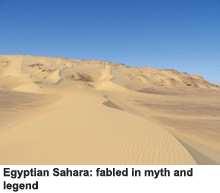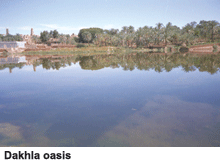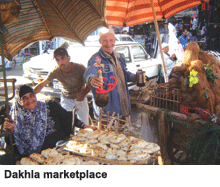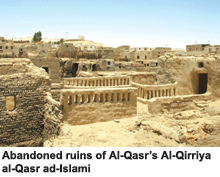Chasing a fantasy to cross the world’s harshest desert in the company of nomadic bedouins, Yoginder Sikand discovers that an entire way of life built on a symbiotic relationship between the Sahara and its people has been transformed
 The overladen omnibus from Cairo chugged down a clogged thoroughfare, and inched across a bridge over the Nile. Already, at this early hour, the road traffic was dense and deafening as workers from rural Egypt poured into Cairo, stuffed in buses, cars and even donkey-carts. A dozen barges and a few luxury liners anchored in the river lazily watched the occasional country boat navigating the murky waters of the Nile. We crawled through decaying suburbs of the city and accelerated through a succession of villages strung along the great river. An hour later we were speeding in sheer, pristine desert. Not just any old desert. This was the fabled Sahara of myth and legend.
The overladen omnibus from Cairo chugged down a clogged thoroughfare, and inched across a bridge over the Nile. Already, at this early hour, the road traffic was dense and deafening as workers from rural Egypt poured into Cairo, stuffed in buses, cars and even donkey-carts. A dozen barges and a few luxury liners anchored in the river lazily watched the occasional country boat navigating the murky waters of the Nile. We crawled through decaying suburbs of the city and accelerated through a succession of villages strung along the great river. An hour later we were speeding in sheer, pristine desert. Not just any old desert. This was the fabled Sahara of myth and legend.
One of my childhood fantasies was to cross the Sahara, the world’s largest and harshest desert, atop a camel and in the company of nomadic Bedouins, moving from oasis to oasis by day and camping under starry skies at night. Several decades later here I was, realising my elusive dream of Saharan exoticism, albeit in an air-conditioned bus, munch-ing cheese crisps and sipping bottled mineral water manufactured by an American multinational company. But I wasn’t complaining. The bus was comfortable, and armed with a dose of history and culture, I was deep inside the Sahara desert.
We raced down a surprisingly smooth highway for four hours, cutting through the desert. Far from mono-tonous, the landscape kept changing as we advanced deeper into the Sahara, travelling south-west. At first, the terrain was pebbly, interspersed with giant black rock formations that loomed on the far horizon. Then, it transmogrified into a landscape dominated by flat-topped hills, displaying a rich profusion of hues — rust brown, pale green, mustard yellow and even peach pink. Later we cut through towering breast-shaped dunes of pure sand lacerated with wavy ripples. Trees, or even a patch of grass, were conspicuously absent.
At noon, the bus pulled into Bahariya, one of the few oases scattered across the vast Egyptian Sahara. I had planned to spend a few days here but as the bus drew into the settlement, I changed my mind. Bahariya wasn’t the remote, unchanged Bedouin outpost in the middle of nowhere that I had imagined. Heaps of garbage rising to pyramidical heights lined both sides of the sand-strewn road. Lank-haired Western tourists sat under rainbow umbrellas planted in the shade of ramshackle motor repair shops. Run-down lodges, incongruously named ‘Cowboy Inn’, ‘Bedouin Delight’, ‘Ali Baba’s Home’, and supermarkets that titled themselves ‘The City Store’ and ‘Madonna Palace’, peeped out from behind rows of date palms. Men in jeans and T-shirts zipped about on motorbikes and pick-up trucks, sending up whirls of dust. Satellite television dishes sprouted like algae on the roofs of squat houses bunched together or huddled below dome-like dunes in the distance. An army of dangerous looking touts invaded the bus and attempted to drag me out, insisting, that I needed a “genuine Bedouin holiday, desert safari and camel-ride”.
Although I had become inured to such hectoring after three weeks in Egypt, I resolved to flee Bahariya as soon as I could. Mass tourism and economic ‘development’ has completely transformed this oasis town. I was in search of the idyllic pastoral simplicity of the Sahara and determined to find it.
Fortuitously, the bus was heading to the farthest oasis in the western Egyptian Sahara — Dakhla, eight hours ahead. So I stayed put. After we drove out of the lush palm groves of Bahariya, the landscape became incrementally austere. Soon, we entered the eerie White Desert, a scorched uninhabited plain that runs for over 100 km where chalk white rock formations have been sculpted into numerous twisted forms by howling winds sweeping across the flat desert plain.
In the forgotten depths of the White Desert where hardly a drop of rain has fallen for centuries, we sped past black camel-hair tents guarded by an occasional donkey and a pair of scraggly goats or camel herds. Bedouins leading camel caravans, whom I had come to visit, were conspicuously absent. And sadly, there were hardly any camels nosing around either. The man sitting next to me said they had been eaten up years ago. The ship and life-blood of the desert had been replaced by Japanese pick-up trucks. The only other proof of human habitation I espied in that vast plain stretching back to Bahariya were a couple of ugly communication towers and boards painted in electric green, announcing the names of God, taken from the holy Quran.
Two hours later, the change of scenery was dramatic. The desert was suddenly interrupted with a riotous array of parrot green buck-wheat fields, and rows of stunted olive trees, fringed by date palms drooping under the weight of ripened fruit. Clear water gurgled in neatly set channels, irrigating mango and banana plant-ations, demarcating low-lying mud walls embellished by bougainvilleas in full bloom. Cows grazed in lush, almost Alpine pastures fenced by slender eucalyptus trees. This was the modestly sized oasis town of Farfara (pop.5,000), where we stopped for tea.
Like Bahariya, Farfara was also overrun by hordes of camera-clicking foreign tourists, shepherded by touts promising them the genuine Sahara experience. This town also offered all the modcons — satellite television, gaily-painted brick houses, shops overflowing with factory made goods, street lighting and some carefully manicured public lawns, complete with see-saws and swings in bright colours. The nomads with eroded faces swathed in turbans, whom I had come to see, were nowhere to be spotted. Only in shops vending mementos could one find traditional Bedouin turbans and gowns, which the town’s well-fed, cheerful and fairly prosperous citizenry seemed to have forgotten.
Pressing on, the bus waded through an immense sea of sand. The sun, now a gigantic orange ball, quickly slid below the horizon. A flock of giant storks flew across the empty sky, now coloured with stripes of brilliant pink, and blushes of red and yellow. And long after darkness had fallen and the clear night sky displayed millions of blinking stars, we finally arrived at Dakhla.
 Although seasoned travellers advise against reliance on travel guides on grounds that they don’t let you discover things on your own, and rob travellers of the suspense and thrill of adventure, in the dead of night in Dakhla’s deserted bus-stand, my copy of the Lonely Planet Guide to Egypt, proved very useful in guiding me towards El-Forsan (‘The Horse’), a modestly priced lodge just a stone’s throw from the bus stop.
Although seasoned travellers advise against reliance on travel guides on grounds that they don’t let you discover things on your own, and rob travellers of the suspense and thrill of adventure, in the dead of night in Dakhla’s deserted bus-stand, my copy of the Lonely Planet Guide to Egypt, proved very useful in guiding me towards El-Forsan (‘The Horse’), a modestly priced lodge just a stone’s throw from the bus stop.
To my pleasant surprise, El-Forsan lodge proved to be far more comfortable than described in Lonely Planet. The inn comprised a dozen mud houses, white-washed in soft cream and lemon shades, topped with domed roofs, and built on a stretch of sand ringed with blooming cactuses. My hut was done “in traditional Bedouin style”. It contained a stone bed, tiny palm wood cupboards built into the walls, and hand-woven rugs with camel and ostrich motifs covering the stone floor. The bed-sheets were crisp and freshly-laundered, and the room had a spacious Roman-like sunken bath with running hot water. Priced at the equivalent of Rs.300 a night, it cost me barely a fifth of what I had paid for a miserable hovel in Cairo. In the comfort of El-Forsan I luxuriated for a week, conveniently forgetting the rugged Saharan adventure I had set out upon.
The next morning, after being awakened by a call to prayer that wafted from a mosque nearby, I stepped out to explore the town. Dakhla (pop.75,000) is a modern town with wide roads and traffic lights. Large bungalows rubbed shoulders with latter-day schools and hospitals, and swank hotels advertised “traditional Bedouin hospitalities” and modern amenities such as spas and safaris. Cafes fringing leafy parks did brisk business with customers watching football matches on giant television sets while puffing away on large nargilehs, the Egyptian counterpart of the Indian hukkah. A convoy of festooned cars packed with revelers celebrating a marriage party, zoomed down the boulevard.
Following a quick lunch of boiled beans and fresh bread straight from the oven, I trudged up a knoll to the Qala, the fort inside which the citizens of Dakhla lived until a few decades ago before the new, modern town sprang up. Labyrinthine paths wound their way to the summit, criss-crossed with shaded passageways lined with mud homes, now in states of ruin. Only a few of them were inhabited by poor families who couldn’t afford to shift to the new town below. Yet the tough trek to the crest of the fort proved worth the effort, for the sweeping vista it afforded. From the top of an enormous stone ridge, all I could see was an ocean of sand and dunes being patterned by the wind, stretching all the way to Sudan in the east, Mali, Libya and Chad in the south and west. This was virgin Sahara at last: the rugged desert wilderness of Lawrence of Arabia and my imagination, and it suffused my being.
 I spent a couple of blissful, uncluttered days in Dakhla, walking through fields, sampling dates and olives accumulated in piles below trees (and which, I conveniently presumed, were free for visitors from afar to pick!), practising my rudimentary Arabic in roadside cafes, and visiting contiguous settlements strewn across the oasis. On my last day, I travelled to Al-Qasr, an hour’s bus ride to the very end of the Dakhla oasis. The landscape was stunning, to put it mildly, patchworked with green fields and verdant orchards growing out of rich, grape-red soil, contrasting sharply with bare stone ridges in the distance, beyond which the Sahara rolled endlessly. As in Dakhla, the only traditional buildings I saw along the way were impressive and expensive newly-built hotels catering exclusively to foreign tourists, and made to look ‘authentically Bedouin’ with tribal rugs and tassels, and pom-poms in merry colours decorating their lavish entrances.
I spent a couple of blissful, uncluttered days in Dakhla, walking through fields, sampling dates and olives accumulated in piles below trees (and which, I conveniently presumed, were free for visitors from afar to pick!), practising my rudimentary Arabic in roadside cafes, and visiting contiguous settlements strewn across the oasis. On my last day, I travelled to Al-Qasr, an hour’s bus ride to the very end of the Dakhla oasis. The landscape was stunning, to put it mildly, patchworked with green fields and verdant orchards growing out of rich, grape-red soil, contrasting sharply with bare stone ridges in the distance, beyond which the Sahara rolled endlessly. As in Dakhla, the only traditional buildings I saw along the way were impressive and expensive newly-built hotels catering exclusively to foreign tourists, and made to look ‘authentically Bedouin’ with tribal rugs and tassels, and pom-poms in merry colours decorating their lavish entrances.
The abandoned ruins of Al-Qasr’s Al-Qirriya al-Qasr ad-Islami (Islamic City) are visible from a distance. Mud structures crowd at the base of a hillock silhouetted against the stark blue sky. The warrens of some 200 structures that make up the settlement are remarkably well preserved, consisting of numerous dwellings (some of them four-storied), the house and attached reception hall of the chieftain of the town, two still functioning mosques, public halls, factories for pressing oil, and barns for storing dates and olives. The buildings are of soft mud, with bound palm trees providing the roofing. Shaded corridors wind their way through the maze of buildings, keeping out the harsh desert sun and the sand is endlessly churned by gusty winds that sweep across the Sahara. No one lives inside the castle, which stands in mute testimony to a flourishing way of life that lasted for centuries until the Sahara was opened up for development.
 In this remote western corner of Egypt, the mighty Sahara has been tamed and modernised. Hardly any Bedouins here, with whom I had dreamt of close encounters. An entire way of life built on a symbiotic relationship between the desert and its people has been irrevocably transformed. The oases of the Egyptian Sahara have morphed into contemporary towns. It was somewhat of a let down, coming all this way to be confronted with universal urban habitats in miniature. But was it fair, I wondered, to expect the Bedouins to remain frozen in time for the gratification of tourists?
In this remote western corner of Egypt, the mighty Sahara has been tamed and modernised. Hardly any Bedouins here, with whom I had dreamt of close encounters. An entire way of life built on a symbiotic relationship between the desert and its people has been irrevocably transformed. The oases of the Egyptian Sahara have morphed into contemporary towns. It was somewhat of a let down, coming all this way to be confronted with universal urban habitats in miniature. But was it fair, I wondered, to expect the Bedouins to remain frozen in time for the gratification of tourists?
With such philosophical conundrums crowding my mind, I packed my bags and headed further north into the Sahara, towards the oasis of Siwa on the Libyan border. I had heard that local Berber tribes had not yet succumbed to the temptations of western modernity. But more of that in the next installment of this travelogue.